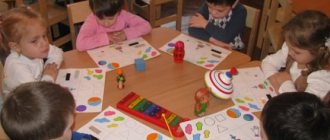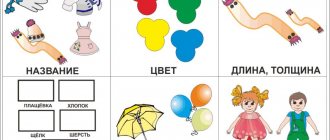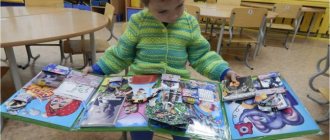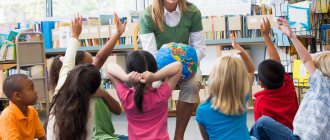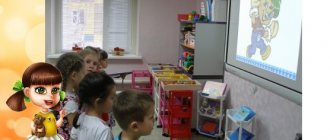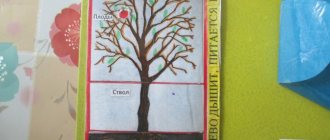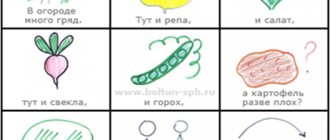CHILDHOOD GUIDE
In accordance with the Federal State Educational Standard for preschool education, the teacher must develop creative activity and creative independence . The fairy tale is fully suitable for developing these personal qualities in children. In addition, work on a fairy tale includes the integration of almost all educational areas according to the Federal State Educational Standard for Education: cognitive , speech , social-communicative and artistic-aesthetic development.
It must be said that fairy tales , as well as many works of art, are not used enough in the family and in the preschool education system for the development of children . For the most part, we are accustomed to a traditional attitude towards fairy-tale material. Over many decades, stereotypes have arisen in this regard: the fox is always cunning, the wolf is evil, the kolobok is always pitied, and rightly so, Pushkin’s old woman was left with nothing. Because one of the tasks facing adults in developing the speech of preschoolers is to introduce the child to the content of a fairy tale, in the best case, to talk about what lies on the surface of the text, to play it out, to dramatize it, to stage it. This is the so-called traditional direction of working with a fairy tale . And non-traditional means teaching children to not only perceive the content in an original, unusual way, in their own way, but also to creatively transform the course of the story, come up with different endings, introduce unforeseen situations, mix several plots into one , etc.
Larisa Borisovna Fesyukova in her book “Education with a Fairy Tale” presented a universal scheme that helps to use fairy tales in an unconventional way, using creative methods, thereby promoting the development of speech in preschoolers. It looks like this: The title of the tale. 1. Moral lesson. 2. Nurturing good feelings. 3. Speech exercises. 4. Development of thinking and imagination. 5. Fairy tale and mathematics. 6. Fairy tale and ecology. 7. A fairy tale develops hands.
The proposed seven sections are chosen tentatively; there may be more or fewer of them. There is no doubt that each fairy tale, in its content, highlights only 1-2 of the problems posed, the rest will be secondary, accompanying. That is, teachers can independently select from the scheme those tasks and questions that seem important , interesting and useful to them for a specific age group of children. Don’t be embarrassed if some fairy tale doesn’t have a “mathematics” or “ecology” section. It is important that, working according to this scheme, you can creatively restructure and rework the fairy tale in any direction that is important to you . This can be a geographical journey, an excursion into the historical past, or instilling attention, a sense of justice, patriotism, etc. An infinite number of directions can be formed. This diagram is just a sample for a teacher’s creative work with a fairy tale .
Let's look at the methodology for completing the most frequently repeated tasks and questions. Why is a “moral lesson” ? With this technique, he takes on the burden of giving the following explanation: what is the main meaning of the fairy tale, what does it aim the child at, what moral principles does it lay in his soul, in his consciousness. It is not for nothing that there is a saying: “A fairy tale is a lie, but there is a hint in it, a lesson for good fellows.” To identify this not always directly formulated “hint” and to clarify its essence is the main task. For example, in the fairy tale “Puss in Boots” you can consider the proverb . ” From this position, the cat cannot serve as an example to follow. Is it possible to imitate someone who, in order to achieve a goal, easily deceives and behaves ugly? "Mitten" . It is proposed to reveal a moral lesson with the help of the proverb “In cramped conditions, but not in offence . No offense, but to the detriment of someone (grandfather lost his mitten, he was cold). Invite children to resolve these contradictions at their level. Or maybe it’s not so bad for the grandfather - the woman will knit new ones for him. "The Princess and the Pea" - the pampering of a princess.
"Cultivating good feelings." There is no need to convince anyone of the importance of the problem at hand. But let us remember that this concept is quite capacious. Remember with your children how they imagine a kind person. Those who love to help others, who can sympathize, empathize, etc. In this case, fairy tales play an important role for the following reason: children love the heroes of fairy tales, they become family and friends for children, and therefore can be role models. task is to direct the children’s thoughts and feelings in the right direction. Explain to children that a kind person does not love people, cannot help but show the generosity of his soul, he sympathizes, has compassion, and respects others. He cannot be envious, rude, arrogant. A kind person can show courage and selflessness. In general, the feeling of kindness is the root of all noble qualities. The teacher can use the following methodological techniques : • prove that the hero is the best; • who do you feel sorry for in this fairy tale; • what would you do in the place of the hero or other characters. It is difficult to deny the role of fairy tales in the development of correct oral speech . The texts of fairy tales expand vocabulary, help to construct dialogues correctly, and influence the development of coherent, logical speech. It is equally important to make our speech emotional, imaginative, and beautiful.
“Speech exercises” - is aimed at solving these problems . So what games for children will contribute to the development of speech creativity, speech development and its activation? 1. This is the ability to ask questions. According to psychologists (A. Zaporozhets, L. Wenger, etc.), the ability to reasonably formulate a question in context is one of the indicators of the successful development of preschool children. Of course, during the day the child situationally asks a lot of questions. But, believe me, it will be much more difficult for him to pose a question to the heroes, for example, of the fairy tale about the hen Ryaba (grandfather, woman, hen or mouse). 2. Constructing words, phrases and sentences. In addition to the spontaneous formation of the basics of oral speech, special training is required. In this regard, the construction of words, phrases and sentences is quite important. Together with the children you need to: • come up with several words with the same root (forest - little forest, little forest); • rhyme two words (blacksmith - daredevil, frog - frog), and then you can and should move on to a rhyming chain and couplets, as harbingers of word creation; • make up a fairly long , common sentence in the game “A word from everyone” (Kolobok – Kolobok is rolling – Kolobok is rolling along the path – Kolobok is rolling along the green path, etc.). 3. Notes, telegrams, short letters. It is well known that the elements of linguistic education are laid down from a very early age. In this regard, it is extremely important not only to teach a child to compose orally, but also to show him the new possibilities that exist in the genre of written communication with each other. The simplest types of such communication are notes, telegrams, short letters. For example, the fairy tale “Little Red Riding Hood” . We decide with the children who it is better to send a note, to whom a letter, and to whom a telegram (and an urgent one at that). And together we begin to compose (the child speaks, and the adult writes, then together we read and discuss what has been written, correcting and improving the content and style). It should be noted that the child sensitively grasps the features of oral and written speech, especially with such constant personal participation. In addition, a telegram (like a note or letter) can be different in its emotional mood and express admiration, gratitude, or warn of danger. This means that there is a connection and interrelation of the speech and moral principles , which are formed in parallel. 4. Phraseologisms and proverbs. Until recently, it was believed that it was difficult for a child to understand the figurative meaning of phraseological units and proverbs. However, research by F.A. Sokhin and other authors showed the inconsistency of this thesis. To help children understand the idea of a fairy tale and the figurative meaning of forms of small folklore , you can offer specially selected phraseological units and proverbs for almost every work. Some of them will correspond exactly to the main meaning of the tale, others will be less suitable. By examining them together with children and discussing the meaning of each of them, we help the child remember sayings, learn to apply them to their place, and more clearly understand the inner content of a fairy tale. For example, the proverb “Not everything is Maslenitsa for the cat” gives rise to a conversation about the ancient Slavic holiday as a holiday of seeing off winter, welcoming spring, with pancakes, burning an effigy of “winter,” folk festivities, and rituals. Isn’t this where the cat’s joy comes from – to be well-fed on a holiday? But holidays don’t happen every day, which means it’s not always Maslenitsa. And when the meaning of a proverb is clear to a child, he is easily captivated by the game of inventing situations for which this proverb would be suitable, or fairy tales where it could rightfully be attributed to the heroes. 5. New names for fairy tales. To develop your speech, often resort to the proven method - coming up with new names for already known fairy tales, without distorting the idea of the work. For example, the fairy tale “Mitten”. New names - “Friendly House”, “Mitten and Animals”, “New House for Animals”, etc. 6. The next educational game for children is the introduction of an invented new character instead of the usual hero. This is necessary: • to maintain interest in the fairy tale, • in order to break the usual stereotypes, • to turn the plot of the fairy tale in a new direction. This method can be called conditionally “Introduction of the particle “not” ” (Not a turnip that grew in the garden, but..., Not Little Red Riding Hood, but..., Not Ivan Tsarevich, but...). 7. To introduce novelty , to complicate the perception of a long-familiar fairy tale, or to create an element of surprise, you can resort to this technique: all verbs or nouns, or parts of words, are extracted . There is no need to introduce your child to such complex terminology (verbs, nouns). Offer the children a game situation: “Some words were offended and ran away from the fairy tale, let’s try to guess what kind of fairy tale it is without them. For example: “Would-be-de-ba-have-no-ku-rya-sne-ku-rya, etc.” 8. It is important to cultivate sensitivity to words . The following techniques in working with fairy tales will contribute to the formation of such a sense: • find affectionate, beautiful, fabulous, sad words; • compose a long and at the same time funny word (about a fox - “long-tailed”, “fluffy-tailed”); • parse words with the same spelling, but with different meanings. This is facilitated by the correct stress (flour - flour), and sometimes a different context (dog's tail - dog's character); • explain the origin of the word. There are many words in fairy tales, the etymology (origin) of which will need to be explained (the back streets); • pronounce a word without vowels and invite the child to recognize it. For example, try saying the word “princess” this way. 9. The relationship between speech and mental activity. To develop speech, you can offer children tasks like “Identify the extra word . The child must, according to the principle of a systematic approach, generalize and select what is needed (only domestic or only wild animals). For example, from a number of words: fox, hare, hut, dog, rooster - the extra word “hut”. It is quite clear that any systematization according to generalized characteristics forms logical thinking. 10. A fairy tale should also develop communication. To develop speech and communication in preschoolers, offer the game “Interview” for children. For authenticity, give your child a microphone or a substitute. And who takes the interview, who gives it, for what reason - all these moments are dictated by the plots of the fairy tale and you can come up with it yourself. 11. Development of thinking and imagination. Its essence is to combine two short stories or fairy tales into one with a new plot. Or take the beginning from one fairy tale, and the ending from another. This is not an easy job for adults either. After all, you need to logically weave new characters into the plot, come up with different content. In this case, both the child’s speech and his imagination play an active role. In this work, the leaders and organizers are undoubtedly adults. 12. Statement of a problematic issue. Children are traditionally asked a lot of questions about the text of the fairy tale. They are often formulated at the level of statements (Where did Little Red Riding Hood go? How did the fairy tale end?) But much more useful are questions of a search nature (why, why, how, and if). For example, “And if the Ogre had not turned into a mouse, how would Puss in Boots have emerged victorious?” Or “What other fairy tales contain cats and mice?” Or, after reading “Cinderella,” the children, with your participation, name the same kind, beautiful, hardworking heroines from other fairy tales (Khavroshechka, sister Alyonushka).
On the connection between fairy tales and mathematics. When we talk about a preschooler, we must keep in mind that it is recommended to connect mathematics as much as possible with the life around us. In this case, a fairy tale is a very good source material. Moreover, the mathematical beginning in many fairy tales is on the very surface ( “Two Greedy Little Bears”, “The Wolf and the Seven Little Goats”, “The Flower - the Seven Flowers” ).
Through a fairy tale, you can reinforce with children such concepts as number, shape, size. The most common question is: “How are they similar and how are they different?” Finding similarities and differences is more a matter of logic, but mathematics does not exist without logic. That is why it is useful for children to practice answering questions like: “How are a simple and a golden egg similar and different?” When children become familiar with geometric figures, it is useful to use them to encrypt and model familiar fairy tales , i.e. hide heroes in figures that can be easily guessed by shape and size. For example, this model is reminiscent of the fairy tale “The Wolf and the Seven Little Goats” . And the two shaded circles represent the fairy tale “Two Greedy Little Bears.” Working in this direction, the teacher gradually leads the children from specifics to abstraction. Or come up with a fairytale problem or a mathematical question. The fairy tale “The Wolf and the Seven Little Goats” . Problem: If one kid ran after his mother, and two others followed him, then how many kids would the wolf find in the hut? — “In the goat’s hut there were 7 kids. The wolf found only 6 kids. How many kids managed to hide from the evil Wolf?”; Fairy tale "Kolobok" . Questions: How many characters (heroes) did the kolo-bok meet when it rolled along the track? What shape is the bun? - “Kolobok sang 2 songs to the Bunny, 3 songs to the Bear, and 4 songs to the Fox. How many songs did Kolobok sing in total?”; — “The sly fox stole 8 fish from the old man. And she gave only one to the Wolf. How many more fish did the Fox eat than the deceived Wolf? -“Cat Bayun performed 10 lullabies. Of these, 3 are for Marishka, 4 for Vanyushka, and the rest for Grishutka. How many lullabies did the cat Bayun sing for Grishutka? and etc.
Formation of ecological culture through a fairy tale. In accordance with the Federal State Educational Standard for preschool education, the task of forming an ecological culture for preschoolers is integrated in the educational areas “Cognitive development” and “Socio-communicative development” . Environmental games for children can be included in the “Fairy Tale and Ecology” . So, when talking about nature, it is important not to miss the explanation of the evolution, dynamics, development of an object or phenomenon . Let's take an apple seed and, together with the child, trace its dynamics: seed - tree - flowering tree - fruit - jam, etc. You can study the path from the end result to the beginning (from jam to seed). It is necessary to bring children to the understanding that everything in nature is interconnected and everything is in development . So, a hare changes color in winter, a fox's tail helps cover its tracks, a giraffe's long neck helps it feed, etc. It is advisable to transfer this understanding of interdependence into fairy tales, helping your favorite characters in their difficulties (it is better to change the color of the bun to green, then it will not be visible on the grass). A more conscious understanding of nature and natural phenomena by children is helped by the game “What if” , which puts the child in the position of a researcher: • What if spring had not come? • What if the wind disappeared? • What if the sun went out? etc. Or the game “Good - Bad” (analogous to “Harm - Benefit”). So, a swamp is bad: you can get stuck, there are a lot of mosquitoes, it looks ugly. But this is good: peat is extracted from it, the swamp feeds nearby rivers, frogs live well in it, etc.
Games for children that develop hand motor skills - “A fairy tale develops hands.” It is no coincidence that it is said, “When I listen, I learn, when I do, I remember.” Children are invited to do something : cut out, glue, depict a fairy tale schematically or using pictography, show an episode of the text using facial expressions and gestures. You can offer to depict something or someone from a fairy tale, but in a non-standard way: - volumetric applique - the appliqué paper is crumpled, slightly straightened, the outline of the object is cut out of it, lightly pasted, then, if necessary, cut out; - finger painting - drawing is done using paints with fingers or fists; - drawing on wet paper - a piece of cotton wool or foam rubber is wetted, then with their help the moisture is evenly applied to the paper. The object is drawn with thick paint; - magic drawing - first the drawing is applied in outline, using a wax candle, and then the top is covered with paint, the contours seem to appear; - monotopy - a design is applied with a brush and paint onto cellophane, then the cellophane is turned over and pressed against the paper; - “living drop” - a large drop of paint, together with paper, tilts in different directions. The resulting drawing is outlined or completed as necessary; - collage - the drawing uses several of the above methods, plus postcards, fabrics, and natural materials.
I draw the attention of teachers to the fact that the proposed material can be the basis for consultations for parents on speech development and developmental speech games for preschoolers, as well as the basis for developing project activities in preschool educational institutions.
You can download “Educational Fairy Tales” on the “Library” in the “Cognitive Development” section.
Dear teachers! If you have questions about the topic of the article or have difficulties in working in this area, then write in the comments . I'll definitely help.
Golovina Bela Gennadievna, site administrator.
Integration of educational areas in the process of physical development of preschool children Working with fairy tales: creative methods Content of educational areas according to the Federal State Educational Standard for Preschool Education Education with fairy tales >
